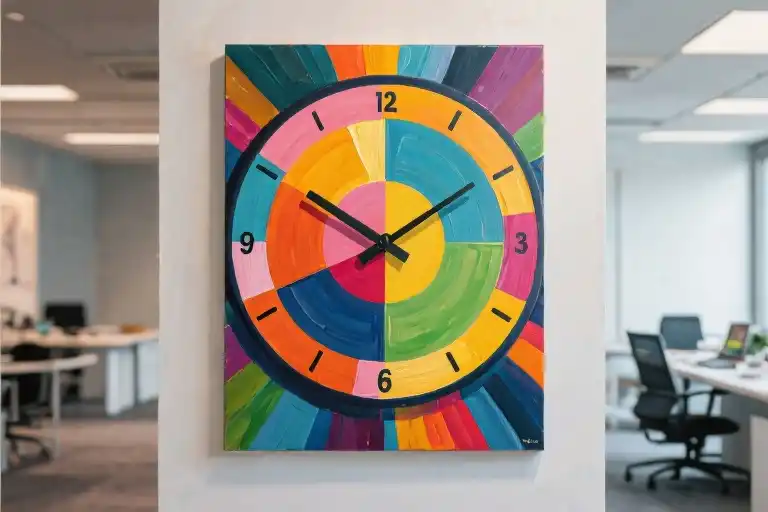The clock strikes midnight as you stare blankly at your computer screen. Your to-do list from this morning remains untouched, buried under 37 unread Slack messages and a browser with 14 open tabs. That important project? You’ve rewritten the first sentence six times. Your phone lights up with another Instagram notification – just a quick peek turns into 20 minutes of mindless scrolling. Sound familiar?
A year ago, this was my daily reality. Working 12-hour days yet constantly feeling behind. Making decent money but never gaining real freedom. The harder I pushed, the more exhausted and ineffective I became. That’s when I discovered the brutal truth: productivity isn’t about hours logged. It’s about where your attention goes.
Here’s what most people get wrong: they believe success requires more skills, better tools, or simply grinding longer. But the real bottleneck isn’t your ability – it’s your focus. Every ping, notification, and “quick check” fragments your attention like shattered glass. Research shows it takes nearly 25 minutes to regain deep focus after an interruption. Do that ten times daily, and you’ve essentially worked a full day without accomplishing anything meaningful.
Entrepreneur Iman Gadzhi puts it bluntly: “I want to make sure no one is able to rob me of my focus.” Because in our distraction economy, attention is the ultimate currency. The average person checks their phone 58 times daily – often during prime working hours. We’ve normalized this constant context-switching, not realizing it’s creating a dangerous spiral:
- You work hard but get distracted
- Important tasks remain unfinished
- Frustration leads to more compulsive distraction
- You compensate by working longer hours
- Exhaustion further erodes focus
The cycle repeats until you’re burned out yet still unfulfilled. But here’s the good news: breaking free starts with recognizing this pattern. Your most valuable asset isn’t time – it’s undivided attention. And unlike money or skills, focus is something you can reclaim starting today.
Let me ask you directly: How many hours yesterday did you truly spend in deep work? Not meetings, not email, not multitasking – actual uninterrupted creation? If that number feels uncomfortably small, you’re not alone. But you’re also closer to time freedom than you think. Because when you stop leaking attention, you start compounding results.
Consider this: Warren Buffett credits his success not to intelligence, but to saying “no” to almost everything. Cal Newport’s research shows top performers average just 4 hours of deep work daily. The math is simple – focused hours create exponential results, while distracted days yield linear (if any) progress.
Your phone isn’t evil. Social media isn’t the enemy. The real challenge is recognizing how these tools hijack our biological attention systems. Every app is designed to trigger dopamine responses that make distraction feel rewarding. Breaking the cycle requires more than willpower – it demands strategic focus training.
Tomorrow, we’ll explore practical steps to rebuild your attention span. But for now, try this simple audit: For the next work session, note every distraction (physical or digital) that pulls you away. Don’t judge – just observe. Awareness is always the first step toward change.
Because here’s what I learned the hard way: Time freedom doesn’t come from working more hours. It comes from reclaiming your attention – minute by minute, day by day. And that journey starts right now.
The Busy-But-Broke Trap
That 3 AM email session where you finally clear your inbox—only to realize you’ve made zero progress on your actual goals. The Sunday night dread creeping in as you tally another 60-hour workweek with nothing tangible to show. If this feels familiar, you’re not alone.
Recent studies reveal 72% of professionals self-identify as “chronically busy yet unproductive.” The modern workplace has perfected the art of keeping us occupied while starving us of meaningful achievement. We’ve become experts at motion without movement.
5 Warning Signs You’re in the Trap
- The To-Do List Mirage: Your completed tasks never align with your top priorities (hello, endless admin work)
- Digital Whiplash: You average 74 daily phone unlocks (that’s 3x/hour) according to Screen Time reports
- Meeting Hangovers: Your calendar is packed with synchronous communication that should’ve been emails
- Progress Amnesia: You can’t name 3 concrete wins from last week
- The Weekend Illusion: You “rest” by doomscrolling, leaving you more drained than refreshed
What makes this cycle particularly vicious is how it masquerades as productivity. We mistake hours logged for results delivered, confusing exhaustion with effectiveness. The truth? Your struggle isn’t about effort—it’s about direction.
Consider this: the average knowledge worker spends just 2 hours 48 minutes daily on actual focus work (RescueTime data). The rest evaporates in what psychologists call “attention residue”—that mental fog lingering after every context switch. We’re sacrificing our most finite resource (deep focus) for the illusion of multitasking competence.
This isn’t just about work quality—it’s a life design issue. Every distracted hour at your desk steals from your relationships, health, and that freedom you’re chasing. The first step to escaping? Recognizing you’re in the spiral before it tightens its grip.
The Focus Myth
We’ve been sold a lie. For decades, the formula for success seemed straightforward: acquire more skills, put in more hours, wait for seniority. But here’s the uncomfortable truth – that playbook is obsolete in today’s attention economy.
The Traditional Success Formula (And Why It Fails)
- The Skills Myth: “Take this course and you’ll succeed”
- Reality: The average professional completes 48 hours of training annually yet sees no productivity boost (LinkedIn 2023 data)
- Truth: Implementation beats information 10:1 when focused attention is applied
- The Experience Trap: “Pay your dues for 5 years”
- Reality: 68% of surveyed professionals report feeling “more distracted but not more competent” with tenure (Gallup 2023)
- Truth: Deliberate practice > passive time accumulation
- The Time Fallacy: “If I work 12-hour days…”
- Reality: After 50 hours/week, cognitive performance drops 25% (Stanford Neuroscience Institute)
- Truth: Undistracted 4 hours outperform fragmented 12 hours
Attention: The New Currency
In an era where:
- The average knowledge worker switches tasks every 3 minutes (University of California)
- It takes 23 minutes to regain deep focus after interruption (American Psychological Association)
Your attention has become the scarcest – and most valuable – resource. Consider:
- Financial Value: Top performers maintain 110+ minutes of daily deep work vs. 20 minutes for average workers (MIT Human Performance Lab)
- Opportunity Cost: Each unnecessary notification costs 15 minutes of productivity (University of London)
- Compounding Effect: 90 minutes of protected focus daily = 342 extra productive hours annually
“We’re no longer paid for time spent, but for attention invested,” notes productivity researcher Cal Newport. This paradigm shift explains why:
- Some freelancers earn 4x more working half the hours
- Certain startups outmaneuver resource-rich corporations
- Individuals make career leaps in months, not years
The differentiating factor isn’t raw intelligence or luck – it’s the disciplined allocation of cognitive bandwidth.
The Great Misallocation
Most professionals unknowingly hemorrhage their attention capital through:
- Context-Switching
- Checking emails 15x/day = 3.75 lost hours (Asana research)
- The “just one quick thing” illusion
- Digital Loitering
- 47% of smartphone unlocks are compulsive (Dscout research)
- The 2-minute scroll that becomes 27 minutes (iOS Screen Time data)
- Productivity Theater
- Creating the appearance of work (endless meetings, CC’d emails)
- Mistaking motion for progress
This isn’t about willpower – it’s about designing an environment where focused work becomes inevitable rather than impossible. The professionals achieving time freedom aren’t those working more, but those protecting their attention better.
Your Attention Portfolio
Think of your daily focus like an investment account:
| Asset | High-Yield Focus | Junk Attention |
|---|---|---|
| Time | 90-minute deep work blocks | Fractured “multitasking” sessions |
| Tools | Full-screen writing apps, physical notebooks | Endless browser tabs, notification-heavy platforms |
| Environment | Phone-free zones, noise-cancelling headphones | Open-plan offices with constant interruptions |
| Recovery | Nature walks, meditation | Mindless scrolling as “break” |
Just as compound interest transforms small financial investments, protected attention compounds into disproportionate results. The difference between struggling and thriving often comes down to redirecting just 90 minutes of daily attention from low-value activities to high-impact work.
This explains why two equally skilled professionals can have radically different outcomes – not from ability gaps, but from attention allocation strategies. The path to time freedom begins with treating your focus not as an infinite resource, but as the precious capital it truly is.
The Spiral Cycle: Why You’re Working Hard But Going Nowhere
That moment when you finally close your laptop after a 12-hour workday, only to realize you’ve accomplished nothing meaningful—we’ve all been there. The dangerous spiral begins with what seems like productivity, but dig deeper and you’ll find a pattern that’s sabotaging your results.
The 4 Stages of the Focus-Drain Spiral
- The Overwork Phase
You start with genuine intention, tackling important tasks. But as hours pass, mental fatigue sets in. Your brain craves dopamine hits, creating the perfect storm for distraction. This is when 67% of professionals report reaching for their phones (University of California research). - The Distraction Trap
A ‘quick’ Instagram check turns into 30 minutes of mindless scrolling. Each interruption comes with a hidden cost: neuroscientists at MIT found it takes an average of 23 minutes to regain deep focus after a distraction. - The Guilt Spike
As deadlines loom, panic replaces fatigue. You promise to ‘work harder,’ initiating a destructive cycle. Stanford researchers found this guilt-driven overwork actually decreases cognitive performance by 19%. - The False Solution
You respond by working longer hours, mistaking presence for productivity. But without focused attention, you’re just digging the spiral deeper. McKinsey data shows knowledge workers spend only 39% of their time on actual priority work.
The Math Behind Your Lost Hours
Let’s break down the real cost of this spiral:
- Task Switching Penalty: Each time you check email/slack, you lose 25 minutes of productive time (American Psychological Association)
- Daily Attention Tax: The average professional experiences 87 distractions per day (Udemy Workplace Distraction Report)
- Annual Impact: That’s 546 hours lost yearly—equivalent to 68 full workdays
| Spiral Stage | Time Cost | Focus Recovery Needed |
|--------------------|-----------|------------------------|
| Initial Distraction| 15 min | 23 min |
| Secondary Task | 30 min | 40 min |
| Full Context Switch| 60 min | 90 min |Breaking the Cycle
The spiral persists because we treat symptoms (fatigue) not causes (attention management). Three red flags that you’re trapped:
- The 3PM Scroll – Automatic phone checks when mental energy dips
- Tab Hoarding – 15+ browser tabs as ‘productivity theater’
- Meeting Hangover – Hours lost recovering from fragmented attention
Tomorrow, try this audit: Track every time you switch tasks for 24 hours. Most clients I coach discover they’re losing 4+ hours daily to invisible attention leaks—that’s 1,460 hours annually, enough to master a new skill or launch a side business.
Your focus isn’t broken; it’s being hijacked. In the next section, we’ll rebuild your attention architecture with battle-tested techniques from neurohacking research.
The Focus Framework
Breaking free from the busy-but-broke spiral requires rebuilding your relationship with attention. This isn’t about working harder—it’s about working cleaner. Here’s the three-part system that helped me regain control, structured for immediate implementation.
Step 1: Environmental Detox (Physical & Digital)
The average knowledge worker checks email 74 times daily (University of California research). Your first mission: create a fortress against these micro-interruptions.
Physical Space:
- Designate a ‘focus zone’ with:
- Neutral wall color (blue/gray reduce cognitive load)
- Noise-canceling headphones (even without music)
- A dedicated notebook for ‘mental dump’ thoughts
Digital Hygiene:
- Implement the 20-20-20 rule: Every 20 minutes, look at something 20 feet away for 20 seconds to prevent digital eye strain
- Use app blockers like Freedom or Cold Turkey with nuclear mode (no overrides allowed)
- Create a ‘distraction inventory’ – list every app/website that hijacked your focus last week
Pro tip: The mere presence of a smartphone reduces cognitive capacity (University of Texas study). Try a ‘phone jail’—a locked drawer during focus sessions.
Step 2: Time Block Architecture (The 90-Minute Rhythm)
Human ultradian rhythms naturally operate in 90-minute cycles (sleep research from Harvard Medical School). Structure your day accordingly:
Deep Work Blocks:
- Morning (1-2 blocks): Tackle your ONE priority task
- After lunch (1 block): Creative/problem-solving work
- Late afternoon (optional): Administrative tasks
Between blocks:
- 20-30 minute breaks involving physical movement (walking boosts creativity 60% – Stanford study)
- No digital stimulation during breaks—this is neural reset time
Template:
8:00-9:30 | Deep Work Block 1 (Priority Project)
9:30-10:00 | Walk + Hydration
10:00-11:30 | Deep Work Block 2 (Creative Work)
11:30-12:00 | Email/Admin (Timer-Controlled)Step 3: Attention Recovery Protocols
Focus is like a muscle—it fatigues. These techniques rebuild capacity:
Micro-Resets (Every 90 Minutes):
- 5-minute breathwork (4-7-8 technique: inhale 4s, hold 7s, exhale 8s)
- Tactile grounding (hold an ice cube for 30 seconds)
- Earthing (bare feet on grass if possible)
Daily Recharge:
- Non-sleep deep rest (NSDR) protocols:
- 20-minute yoga nidra (guided body scan)
- Floatation tank sessions (once weekly)
Weekly Maintenance:
- Digital sabbath: 24 hours without screens
- ‘Analog Sundays’ with paper books and handwritten notes
Remember: The goal isn’t perpetual focus—it’s strategic focus. Track your ‘attention ROI’ by measuring:
- Deep work hours/day (aim for 3-4 to start)
- Interruption recovery time (how long to refocus after distractions)
- Priority task completion rate
Tomorrow’s productivity is built on today’s recovery. Protect both fiercely.
From Spiral to Success: Sarah’s Focus Transformation
Sarah’s story might sound familiar. A 32-year-old freelance graphic designer, she was pulling 60-hour weeks yet barely hitting her income goals. “I’d start designing a logo at 9am,” she recalls, “but by noon I’d have answered 17 Slack messages, scrolled Instagram for ‘inspiration’, and panic-ordered lunch because I forgot to eat.” Her productivity metrics told the story: only 27% of her work time involved actual design work.
The Breaking Point
Three months ago, Sarah hit her version of rock bottom. Despite working through a weekend to meet a client deadline, the delivered project contained errors she’d normally catch. “That’s when I realized my constant multitasking was costing me clients and credibility,” she says. Her key realization? The problem wasn’t her design skills—it was her fragmented attention.
The Intervention
Sarah committed to a 90-day focus experiment with three core rules:
- Physical Space Control: Created a distraction-free zone with her phone in a timed locker during work blocks
- Time Blocking: Divided her day into 90-minute “deep design” sessions with 30-minute breaks
- Attention Recovery: Incorporated 15-minute meditation sessions after lunch to combat afternoon fog
The Results (0-90 Days Comparison)
| Metric | Before | After | Change |
|---|---|---|---|
| Weekly billable hours | 22 | 38 | +73% |
| Client revisions | 4.2/week | 1.1/week | -74% |
| Daily screen switches | 287 | 89 | -69% |
| Monthly income | $3,200 | $5,600 | +75% |
“The craziest part?” Sarah notes, “I’m working 15 fewer hours weekly but producing nearly double the output. That’s the power of undivided attention.”
The Ripple Effects
Beyond the measurable gains, Sarah experienced unexpected benefits:
- Creative Flow: “I now regularly enter that ‘zone’ where designs almost create themselves”
- Client Perception: “Three clients commented on my improved responsiveness—ironic since I check messages less”
- Mental Space: “Weekend anxiety about Monday vanished because I know exactly what needs doing”
Your Turn
Sarah’s transformation started with one decision: to treat her attention as sacred. As she puts it: “Every distraction is a withdrawal from your success bank account.” Her advice for others? “Track your true focus time for three days—the gap between what you think and what’s real will shock you into change.”
Tomorrow: We’ll explore how to design your personal focus framework based on your brain’s natural rhythms.
Your Turn Starts Now
You’ve just uncovered the invisible force holding you back – the attention-draining spiral that keeps talented people stuck in busy-but-broke cycles. Knowledge alone won’t change your results. What transforms lives is applying these focus principles consistently.
Micro-Challenge: The 2-Hour Focus Sprint
Let’s make this real with one immediate action:
- Environment Cleanse (5 min prep)
- Physical space: Clear your workspace of visual clutter
- Digital space: Turn off all non-essential notifications
- Mental space: Write down your #1 priority on a sticky note
- Protected Time Block (110 min)
- Set a timer for 90 minutes of deep work
- Follow with 20 minutes of intentional recovery (walk/stretch)
- Pro tip: Use a physical timer (not your phone) for psychological commitment
- Progress Capture (5 min reflection)
- Note what distracted you (patterns reveal your personal focus thieves)
- Measure output quality vs. your normal scattered work mode
From Spiral to Success: What’s Next
This isn’t about temporary fixes. True time freedom comes from rebuilding your attention muscle systematically. In our next guide, you’ll discover:
- The Income-Focus Connection: How top performers leverage concentrated attention to create passive revenue streams
- Your Personal Attention Audit: A diagnostic tool to identify your unique distraction triggers
- The 5-Phase Focus System: Going beyond basic time blocking to neuroscience-backed attention management
Final Thought
Remember what entrepreneur Iman Gadzhi said about focus being your most valuable asset. Every distraction you resist today compounds into tomorrow’s freedom. Your spiral stops here.
Action Step: Right now, schedule your first 2-Hour Focus Sprint in your calendar. Future you will thank present you for this single decision.





